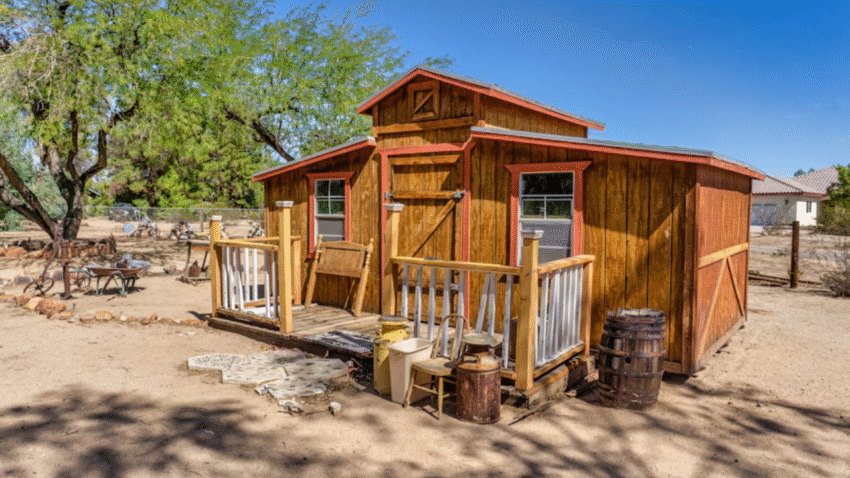Introduction
Is your shed showing signs of wear and tear? Learning how to inspect your shed for damage is the first step to keeping it safe, functional, and long-lasting. Regular inspections help catch problems early—before they turn into expensive repairs. A simple routine check can save you time, money, and frustration while extending the life of your shed.
Why Inspecting Your Shed Matters
Over time, sheds face constant exposure to sun, rain, wind, and pests. Small cracks, leaks, or structural issues can go unnoticed until they cause serious damage. Inspecting your shed regularly ensures that roofing, siding, flooring, and doors stay in good shape. Early detection of damage helps you fix minor issues quickly, preventing rot, mold, or even collapse.
Step-by-Step Guide to Inspecting Your Shed for Damage
1. Walk Around the Exterior
Start with a full visual inspection from the outside. Look for peeling paint, loose siding, rust, or any visible cracks in the structure. Pay close attention to the roof and foundation area for signs of sagging or water pooling.
2. Check the Roof
Climb a ladder (if safe to do so) and inspect shingles or metal panels for damage. Look for missing shingles, rust spots, or holes that could cause leaks. Gutters and downspouts should also be checked for clogs or detachment.
3. Inspect the Siding and Walls
Check for cracks, warping, or holes in the siding. Gaps in walls can let in pests and moisture. If your shed is wooden, look for signs of rot or insect damage.
4. Examine Doors and Windows
Open and close doors and windows to make sure they operate smoothly. Check for gaps, broken locks, cracked glass, or damaged weatherstripping.
5. Look at the Foundation and Floor
Inside the shed, check for sagging or soft spots in the floor. Look around the foundation for signs of sinking, erosion, or rodent burrows. A sagging floor can be an early sign of structural weakness.
6. Inspect the Interior Walls and Ceiling
Look for water stains, mold, or mildew inside the shed. These are indicators of roof leaks or poor ventilation. Examine corners for pest droppings or chewed wood.
7. Check for Moisture and Ventilation Issues
A musty smell often means excess moisture. Make sure vents are clear and working properly. Poor airflow can lead to rusted tools, mold growth, and rotting wood.
8. Test Hardware and Fixtures
Check hinges, locks, handles, and any electrical fixtures. Tighten screws, lubricate moving parts, and note anything that needs replacing.
9. Create a Repair Checklist
As you inspect, make a list of all necessary repairs—sorted from urgent (like leaks or structural issues) to minor (like touch-up paint or replacing weatherstripping).
Common Mistakes to Avoid
- Skipping Regular Inspections
Solution: Check your shed at least twice a year—spring and autumn—to catch seasonal damage. - Ignoring Minor Issues
Solution: Even small cracks or leaks can lead to major problems if left untreated. - Not Checking the Roof Thoroughly
Solution: The roof is the most common source of shed damage. Inspect it carefully for missing shingles or rust holes. - Forgetting the Foundation
Solution: Always look for signs of soil erosion or sagging that can compromise shed stability. - Overlooking Pest Damage
Solution: Check for droppings, nests, or gnawed wood—pests can quickly ruin a shed’s structure.
Extra Shed Tips & Hacks
- Keep a Maintenance Log: Record inspections and repairs to track recurring issues.
- Use a Moisture Meter: Helps detect hidden damp spots before mold becomes visible.
- Trim Surrounding Vegetation: Keeping plants away from the shed prevents pest infestations and water damage.
Want more tips for a stronger shed? Check out our guide on how to weatherproof new shed construction.
Conclusion
Regular inspections are key to keeping your shed in top shape. By checking the roof, siding, foundation, doors, and interior, you can catch problems early and prevent expensive repairs.
Make shed inspections part of your seasonal routine—it only takes a short time but can save you big headaches in the future.
Bookmark this guide to ensure your shed stays safe, secure, and functional for years to come!
